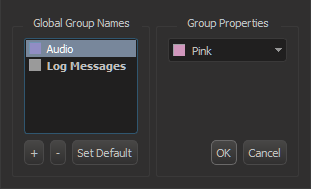Timed Sequences
Timed sequences execute a series of events at a precise time, specified down to the frame. The events in a timed sequence can be viewed either as a grid, or as a visual timeline where events can be adjusted via drag-and-drop.
All timed sequences in your script that are currently running execute in parallel and and can be played, stopped, paused, or scrubbed independently.
Though each sequence may be at a different execution time, they all tick along as precisely the same rate. 1 hour of time passed in one sequence is exactly one hour in any other sequence. More importantly, the same is true between two separate devices (such as two separate show controllers), when they are locked together using Sync Core.
This idea that a timed sequence running on one device can run in perfect lock-step with the media or sequence running on another device is extremely powerful, and is the backbone of many effects and techniques used in theme parks for decades.

Using Timed Sequences
Whenever you need to ensure that two pieces of media, I/O, or effects trigger at a precise time, a Timed Sequence is the correct choice. In order to ensure perfect sync between devices, even with less-than-ideal network conditions, Timed Sequences coordinate the exact start time of each event between devices in advance of the actual event execution time. We call the amount of time before the event that this coordination happens, Pre-Roll. By default, the pre-roll time is 1 second. This can be adjusted up or down depending on network conditions.
Because of this behavior, the pre-roll time acts as the latency to start a Timed Sequence. If pre-roll is set to 15 frames on a 60hz script, events in the sequence will begin executing 250ms after the sequence has been instructed to start. For zero-latency start as quickly as possible, use a Logical Sequence.
Note
Life is about trade-offs. Logical sequences may execute immediately, but if you have 100ms of network latency, then any external devices that are started in that sequence may be starting 100ms later than desired. Timed sequences have pre-roll latency, but guarantee the same start time across all devices. Learn more here.
Current Time
Each timed sequence uses either its own internal clock or an external clock. Each sequence has it's own internal clock, so you might have a sequence at 00:00.10.15 and another at 00:00:01.23. In the case of an external clock like SMPTE LTC, all sequences follow the same clock.

Current Time is displayed in hours:minutes:seconds.frames at the sequence frame rate
Timeline / Grid View
Press the Timeline button to show the timeline view of the sequence or press the Grid View button to show the grid view of the sequence. Drag up from the bottom of the timeline view or down from the top of the grid view to display a split screen of both views.
Groups
Groups can be used to organize and color-code events when in the timeline view. While in timeline view, press the Groups button to add and remove event groups. Each group can be assigned its own background color.

Drag-and-drop events between groups to organize them.

Click the Group name to open or close groups.
